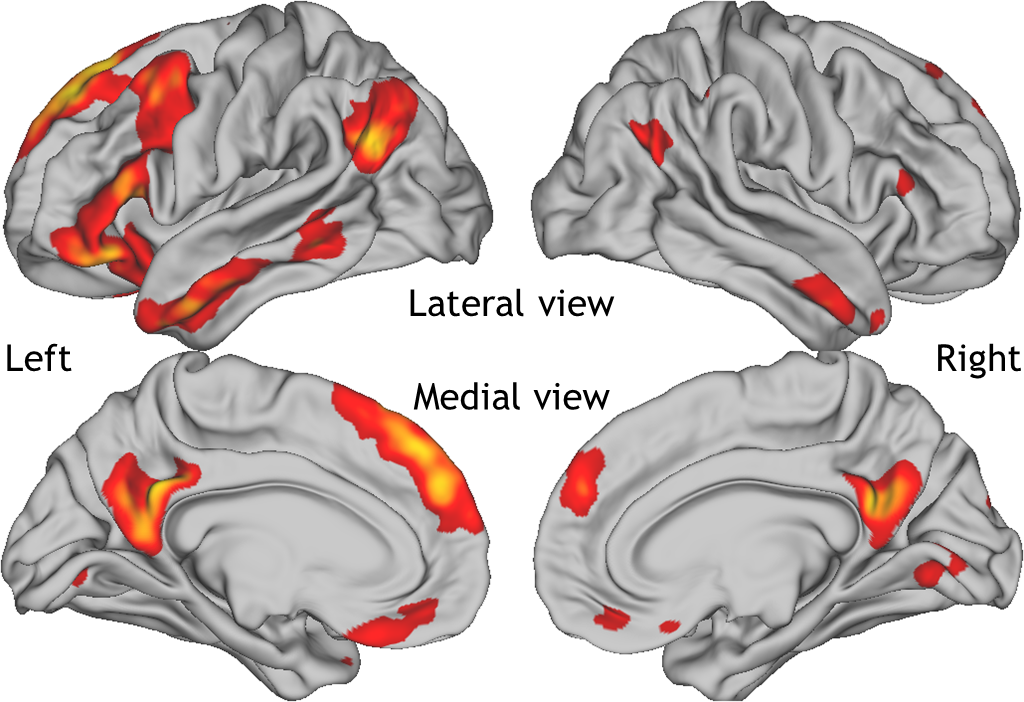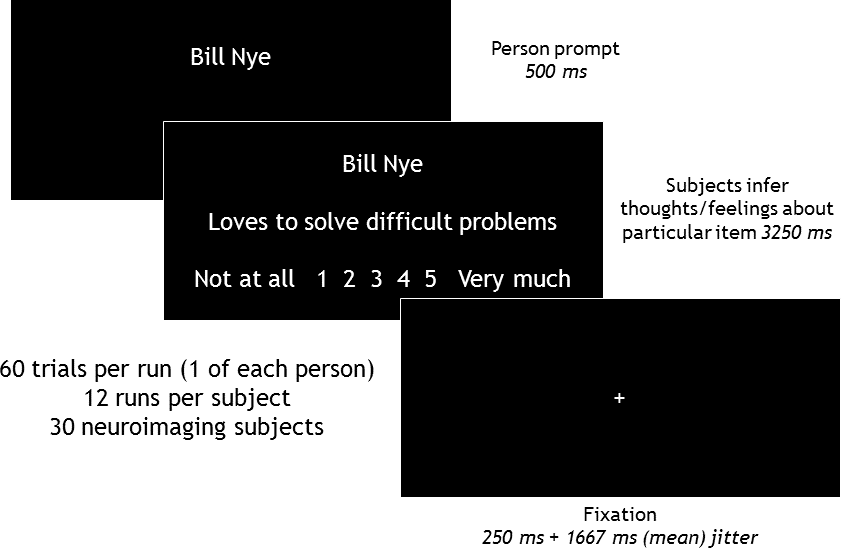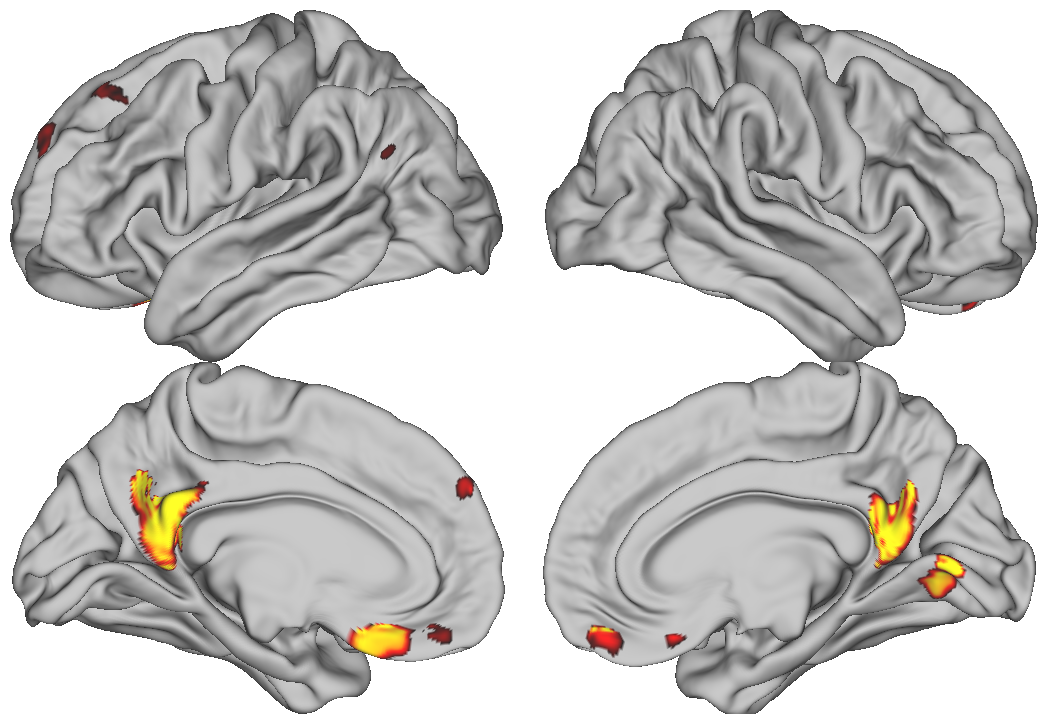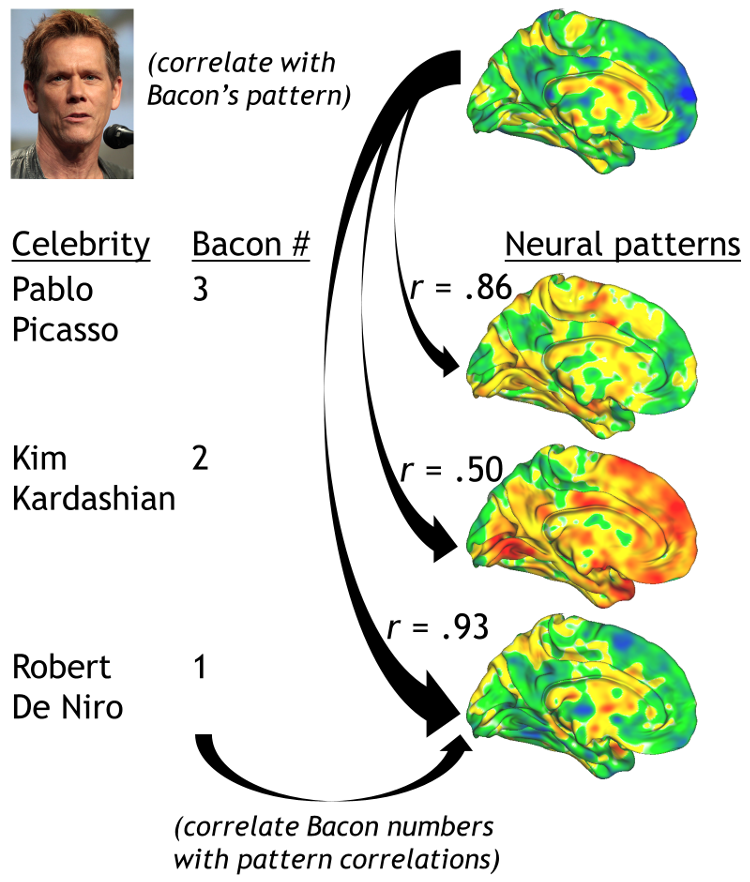Postings on science, wine, and the mind, among other things.
Celebrities on the Brain
Illustrating MVPA with neural degrees of Kevin Bacon

In red/yellow, brain regions within which activity changes significantly (FWE p < .05) depending on who you're thinking about. Similar patterns of neural activity have been elicited across a large number of fMRI studies over the past decade when comparing social vs. nonsocial cognition.
This week I'll be discussing my main line of research for the first time here. This research focuses on neural organization of social knowledge – how our brains make sense of the mental states and traits of other people. I try to understand how the mind distills the enormous complexity of the social world down to its essential – and useful – ingredients. To this end, I use fMRI to examine patterns of neural activity elicited by thinking about other people with various traits and mental states. With multivariate/multivoxel pattern analysis (MVPA), I am able to discover the similarities and differences between the neural representations of particular traits and states and determine which theoretical dimensions or groupings best account for them. In this post I'll talk a bit about MVPA and provide a less-than-serious illustration of how it works. I'll assume the reader already has a baseline level of familiarity with fMRI methodology.
MVPA actually refers to a variety of different approaches united by their focus on distributed patterns of neural activity. If you have read reports in the popular press about using fMRI for "mind-reading," the scientific studies involved frequently involve MVPA. Some fairly impressive acts of mind-reading (really more like brain-reading) have been accomplished using MVPA, such as reconstructing videos people are watching from neural activity. However, the real scientific value of MVPA lies in combining these technical feats - which alone don't shed much light on how people actually think - with testable psychological and neural theories.
MVPA is complex enough that even now - nearly 15 years after its introduction - its details remains obscure to many researchers. To help popularize the technique, the rest of this post will walk through an example of one type of MVPA which I've used extensively: representational similarity analysis. The data come from a neuroimaging experiment I completed earlier in the year. To keep things light, I won't be using any of the real psychological theories that the experiment aimed to test. Instead, we'll entertain the notion that what really shapes the pattern of neural activity elicited by thinking about a person is that person's Bacon number.
![Kevin Bacon by Gage Skidmore [CC BY-SA 2.0 (http://creativecommons.org/licenses/by-sa/2.0)], via Wikimedia Commons](../../images/Kevin_Bacon_SDCC_2014.jpg)
For those of you unfamiliar with Bacon number, it's defined as the number of feature films it takes to link someone to the actor Kevin Bacon. The idea is based on the theory that everyone is only (at most) six degrees of separation away from anyone else in the world. You can look up a person's Bacon number (or indeed the number of links between any two people) at The Oracle of Bacon which uses IMDb to track the social network of the movie business. Of course, people who have no connection whatsoever with films won't have a defined Bacon number. See here for a nice quick quantitative look at the properties of Bacon numbers. As it turns out, the vast majority of actors and actresses have Bacon numbers of five or less.
fMRI experiment
I'll spare you most of the gruesome detail that would normally go into the methods section of one our manuscripts, but I'll mention a few elements of the study design that will be useful for understanding the coming description of MVPA. In this experiment, participants lay in the fMRI scanner while making judgments about the minds of a set of 60 famous people. These famous people were chosen in a data-driven way using a combination of web scraping from Wikipedia (using the python package) and surveys conducted through Amazon Mechanical Turk. The set is biased in a number of ways - for example only 10/60 are women - which is less than ideal (morally and experimentally), but a natural consequence of relying on people's (inherently biased) perceptions.
The MRI machine at the Harvard Center for Brain Science.
We designed the experimental task - based on a previous design in the lab - to elicit social knowledge with respect to a wide range of target people. The figure below provides a schematic illustration of how this task proceeded. On each trial, participants would first see the name of one of 60 famous people. A half-second later, a statement and a 1-5 scale would appear. Participants would try to infer how well the statement applied to the person in question. This would then be followed by a period of fixation (i.e. no task) before the next trial started.

We used famous people as targets for our participants to make inferences about for two main reasons. One is that participants already know things about these people from the real world, and we don't have to artificially "teach" them about fictional characters. Using relatively rich, naturalistic stimuli increases the validity of our research. However, if this was the only concern, we could have use personally familiar others (friends and family). The other advantage of famous people is that all of our participants could think about the same group of target people. This would be very difficult with personally familiar others unless we recruited a close community (and there are other problems with that). Although obviously some participants would know some of the target people better than others, the common reference set opens up a wide range of analytic interesting possibilities that simply wouldn't be practical otherwise. Below you can see the brain regions sensitive to the relative fame of the target people.

In red/yellow, brain regions where activity increases with the fame of the person being considered.
Analyzing the data
Before statistical analysis, we applied some basic preprocessing to the data, including correcting for participant head motion and normalizing to a standard template brain. We then modelled the activity in each voxel using the general linear model (i.e. basically just a multiple regression at each point in the brain). The predictors of interest in that model were the 60 famous target people, resulting in brain maps indicating how much each voxel's activity was related to thinking about the person in question. We smoothed these patterns and averaged them across participants to create 60 canonical patterns of neural activity, each corresponding to one celebrity. The smoothing and averaging aren't typical MVPA steps, but they're useful here for reasons I won't go into now. Just for fun, z-scored versions of those maps are included at the end of this post. We don't actually use the whole-brain pattern in our MVPA - only the pattern from areas which actually have reliably signal for people. That roughly corresponds to the areas in the first image above. All of this was done using SPM8w, a version/wrapper of the Matlab package SPM8. The brain visualizations were made using Connectome Workbench.
Having obtained these activity patterns, the actual process of representational similarity analysis is relatively straightfoward. Using our model (in this case, Bacon number) we predict how similar our stimuli (the famous people) should be to one another. We then correlate the patterns with one another to estimate how similar they really are. We can then correlate our simliarity predictions with our similarity estimates to see how well our model explains the data. The schematic below illustrates this process.

Note that when we correlate pattern similarity with Bacon number, we need to flip one of their signs to make sure that we're either comparing similarity to similarity or distance to distance (otherwise we'll end up with a negative correlation for a good model, which is confusing). Also note that in most representational similarity analyses, we would compare every pair of stimuli (e.g. Kim Kardashian with Robert De Niro) rather than just comparing each with a single reference image. I've limited the present analysis in this way to be as fair as possible to the Bacon model. Since some of our famous people did not have defined Bacon numbers, only 48 of them are included in this analysis.
So how does Bacon number actually do at capturing patterns of neural activity? Not great: r = .18. The distribution of Bacon numbers is definitely not normal, and correlation coefficients are not normally distributed in principle, so we use a permutation test to assess the statistical significance of the relationship: p = .23. The failure of the Bacon model isn't terribly surprising, of course - it was never a very plausible candidate for encoding our social knowledge. The study was actually designed to test a number of real theories such as the Five Factor Model of personality and the stereotype content model. However, those results will have to wait for another time. For the moment, I hope that this post has helped some of you understand (a form of) MVPA just a bit better.
Patterns elicited by thinking about the 60 celebrities
For entertainment, I've included images of the patterns of brain activity associated with thinking about each of the 60 celebrities in the experiment. Please do not take these too seriously - they're just for fun! Few of the observable differences between the patterns would be statistically reliable, especially after correcting for the multiple comparisons that would be involved in testing so many images. Also, please note: more activity ≠ somehow "better" - brain activity doesn't work like that. Click on any of the buttons below, arranged in no particular order, to view the corresponding pattern.

© 2015 Mark Allen Thornton. All rights reserved.
